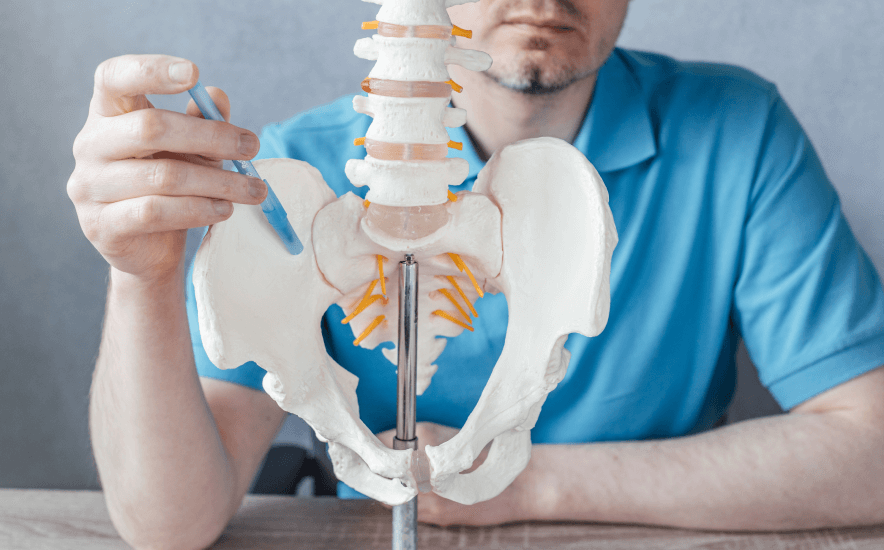
What is Sacroiliac Joint Pain?
Sacroiliac (SI) joint dysfunction or disease refers to abnormal movement or inflammation in the sacroiliac joints, which connect the sacrum (the triangular bone at the base of the spine) to the iliac bones of the pelvis. These joints play a key role in stabilizing and supporting the lower body, transferring the weight of the upper body to the legs. When the SI joints are not functioning properly, they can cause pain in the lower back, buttocks, hips, or even down the legs.



Relevant Symptomatology

Lower Back Pain

Buttock Pain

Leg Pain

Hip & Groin Pain

Stiffness

Limited Range of Motion

Worsened Pain with Movements

Asymmetrical Posture or Gait
Expanded Guide
- Lower Back Pain: The most common and prominent symptom is lower back pain, which is often localized to one side of the lower back but can also be bilateral, affecting both sides. This pain is typically described as a deep, aching discomfort, which can sometimes be sharp or stabbing, especially during movement or activities that place stress on the joint.
- Buttock Pain: Another common symptom is pain radiating into the buttocks, which can often be mistaken for sciatica, as it follows a similar pattern.
- Leg Pain: Unlike sciatica, which typically travels down the leg, the pain from SI joint dysfunction usually stays above the knee, although in some cases it can radiate farther down the leg. This leg pain is often referred to as “pseudoradiculopathy” because it mimics the symptoms of nerve compression but is actually caused by irritation in the SI joint.
- Hip & Groin Pain: Hip and groin pain are also frequently reported, particularly when the dysfunction involves inflammation of the joint or when the surrounding muscles and ligaments become irritated. The connection between the pelvis and the SI joint makes these areas prone to discomfort, especially during activities that involve hip movement or weight-bearing, such as walking or climbing stairs.
- Stiffness: Stiffness is another key symptom of SI joint dysfunction. Individuals often experience stiffness in the lower back, pelvis, and hips, particularly after sitting or lying down for extended periods. This stiffness can make movements, like getting up from a seated position or bending forward, feel restricted and uncomfortable.
- Limited Range of Motion: The limited range of motion in the lower back and pelvis can also affect daily activities, making it difficult to stand, walk, or engage in physical activities for long periods.
- Worsened Pain with Movements: The pain and stiffness associated with SI joint dysfunction typically worsen with specific movements that place additional stress on the joint. Activities such as bending, twisting, lifting heavy objects, or transitioning from sitting to standing can exacerbate the symptoms. Even standing or walking for prolonged periods may increase discomfort, as these activities place pressure on the SI joint, leading to inflammation or irritation.
- Asymmetrical Posture or Gait: In some cases, individuals with SI joint dysfunction may develop an uneven posture or gait. This happens because the pain or stiffness may cause them to favor one side of their body, leading to an asymmetrical way of walking or standing. Over time, this compensatory behavior can lead to further strain on the muscles and joints, exacerbating the condition and contributing to additional discomfort.
Frequently Asked Questions
Have more questions? Schedule a consultation with Dr. Patel to gain additional insights and discuss treatment options. We are committed to advancing your health through patient education and a safe, minimally invasive approach.
Diagnosis typically involves a combination of medical history, physical examination, and imaging tests such as X-rays, CT scans, or MRIs to rule out other conditions. SI joint injections with numbing agents may also be used to confirm that the SI joint is the source of pain.
Treatment for SI joint dysfunction varies based on the severity of the condition but often includes physical therapy to strengthen muscles and improve joint function. Anti-inflammatory medications, pain relievers, and SI joint injections with corticosteroids can also help reduce symptoms. In more severe cases, chiropractic adjustments or manual manipulation may be beneficial, while surgery, such as SI joint fusion, is an option for those with chronic or debilitating pain. Although SI joint dysfunction may not be entirely "curable," many people successfully manage the condition with conservative treatments, although symptoms may occasionally flare up.
The duration of sacroiliac (SI) joint dysfunction or disease can vary significantly depending on the cause, severity, and response to treatment. In some cases, it may be a temporary condition that improves with proper care, while in other cases, it can become chronic. For acute cases, such as those caused by injury or overuse, symptoms may last from a few days to a few weeks, often improving with rest, physical therapy, and medications as the inflammation subsides. However, in chronic cases—often associated with degenerative conditions like osteoarthritis or inflammatory diseases such as ankylosing spondylitis—the symptoms can persist over a longer period. In these situations, ongoing management through treatments like physical therapy, medications, lifestyle changes, and, in severe cases, surgery may be necessary. Although chronic cases may not fully resolve, many people are able to manage their symptoms with treatment, experiencing periods of relief between flare-ups. The focus of treatment is typically on reducing pain, improving mobility, and enhancing quality of life, even if the dysfunction itself remains.
Sacroiliac (SI) joint dysfunction or disease can lead to complications if left untreated or improperly managed, although severe complications are relatively rare. One of the most common issues is the development of chronic pain in the lower back, hips, buttocks, or legs, which can significantly affect a person’s quality of life by limiting mobility and interfering with daily activities. Over time, this chronic pain may also contribute to mental health concerns, such as anxiety or depression. Additionally, individuals with SI joint dysfunction may unconsciously alter their posture or the way they walk to compensate for pain, which can lead to muscle imbalances and strain on other joints, potentially causing further musculoskeletal problems. Reduced mobility and flexibility in the hips and lower back are also possible as stiffness and inflammation limit the range of motion. Chronic SI joint dysfunction may also contribute to joint degeneration, increasing the risk of developing conditions such as osteoarthritis in the affected joints or nearby areas. The dysfunction can place additional strain on other parts of the musculoskeletal system, potentially causing secondary problems, such as lower back, hip, or knee pain. In severe cases requiring surgery, complications such as infection, nerve damage, or failure of the procedure to alleviate symptoms may arise, though surgery is typically considered only when other treatments fail. Addressing SI joint dysfunction early through treatments like physical therapy, medications, and lifestyle changes can help reduce the risk of these complications and improve long-term outcomes.
Gramercy Center
Take the first step towards a healthier life by scheduling your initial consultation with Dr. Patel. At our clinic, we specialize in minimally invasive procedures that offer faster recovery, improved function, and decreased pain. Our client-centered approach ensures that you receive the highest quality care tailored to your unique needs. We look forward to offering you an exceptional experience.
